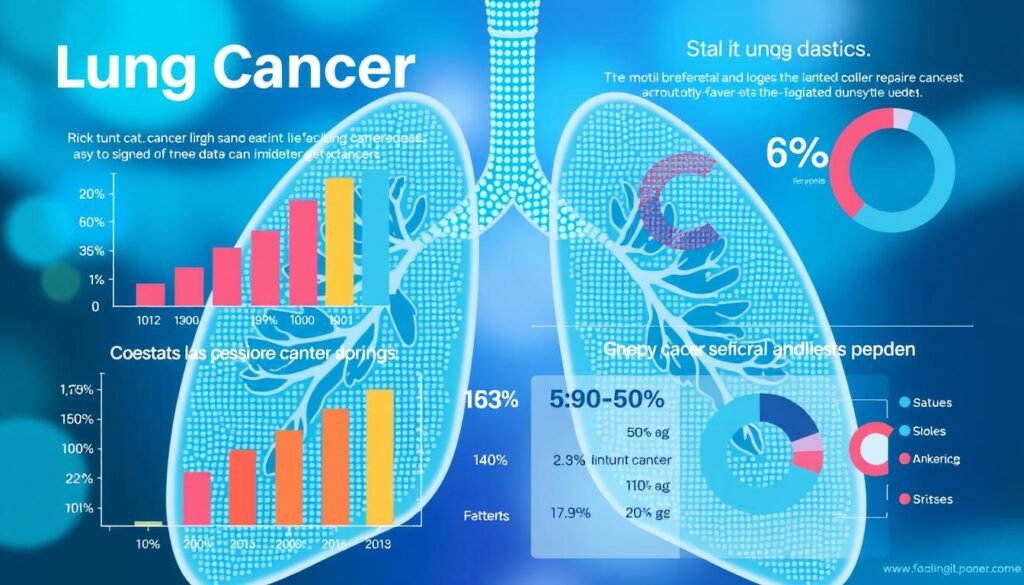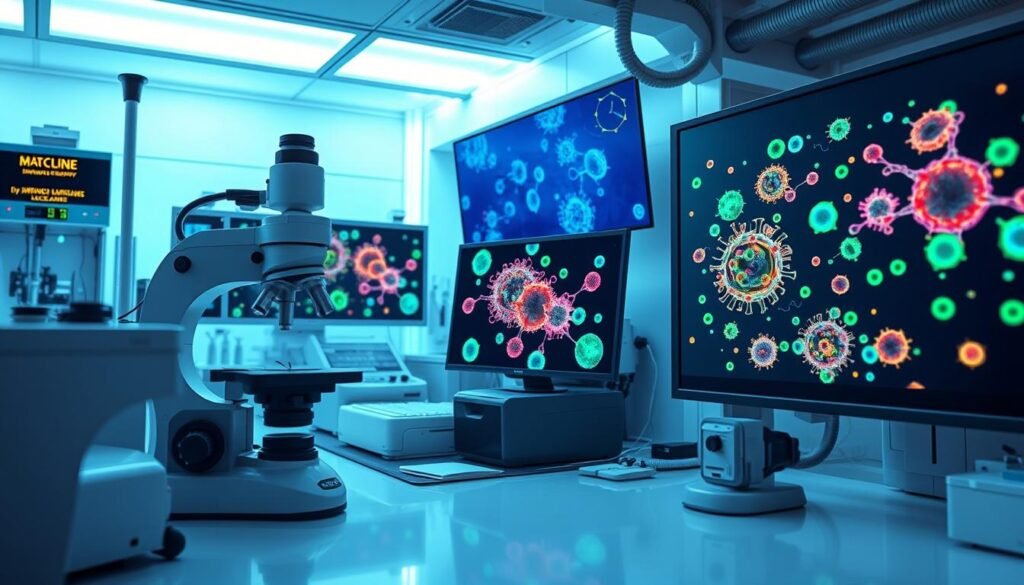Lung cancer is the second-most common cancer and the top cause of cancer death in the U.S. It claims over 150,000 lives yearly. This highlights the urgent need for better treatments. Luckily, new therapies are changing the game, improving how we fight this illness. These therapies use our immune system and attack the cancer’s genetic changes.
New treatments like immunotherapy drugs, genetic tests, and personalized plans are truly making a difference. Drugs that block PD-1 and PD-L1 proteins are especially good against non-small cell lung cancer. With ongoing research, there’s even more hope for patients battling lung cancer today.
Key Takeaways
- Lung cancer remains the leading cause of cancer mortality in the U.S.
- Immunotherapy is becoming standard care for lung cancer treatment.
- Targeted therapy focuses on specific genetic mutations in cancer cells.
- Comprehensive genetic testing helps guide treatment options.
- Clinical trials are vital for advancing lung cancer therapies.
- Minimally invasive techniques are increasingly used in surgeries.
- Early detection significantly improves survival rates.
Introduction to Lung Cancer
Lung cancer is a complex disease. It involves uncontrolled cell growth in lung tissues. It’s often caused by genetic mutations, which can be triggered by smoking, air pollution, and radon exposure. Understanding the different cancer types is crucial for choosing the right treatment.
Lung cancer overview gives key insights into the disease’s nature and progression. It’s the top cause of cancer deaths worldwide. Knowing more about lung cancer is key for better understanding and awareness. The main types of lung cancer are:
- Non-Small Cell Lung Cancer (NSCLC) – makes up around 85% of cases. It has various treatment options like surgery, chemotherapy, and targeted therapy.
- Small Cell Lung Cancer (SCLC) – it’s rarer but more aggressive, usually treated with chemotherapy and radiation.
Early detection is key for better outcomes. Screening can catch lung cancer early, improving chances of survival. It’s important for patients to explore different opinions for treatment options. This means talking to several specialists to find the best approach for them.
Understanding Lung Cancer Types
Lung cancer falls into two key types: non-small cell lung cancer and small cell lung cancer. Knowing about these types helps doctors find the right treatments. It also helps them predict how well patients will do. Each kind of lung cancer is different and affects treatment choices a lot.
Non-Small Cell Lung Cancer (NSCLC)
Non-small cell lung cancer makes up about 80% to 85% of all lung cancer cases. It has several subtypes like adenocarcinoma, squamous cell carcinoma, and large cell carcinoma. Each one acts differently and responds differently to treatment. Adenocarcinoma is the most common kind. It’s seen in smokers and non-smokers alike, often in younger people and women. Squamous cell carcinoma is mainly linked to smoking. It starts in the central parts of the lungs, close to the bronchus.
Large cell carcinoma, meanwhile, can appear in any lung area. It grows quickly and is hard to treat.
Small Cell Lung Cancer (SCLC)
Small cell lung cancer accounts for about 10% to 15% of lung cancer cases. It’s known for being very aggressive. It’s often found late, after it has spread. This spreading early on makes treating SCLC tough.
Even though it’s less common, its quick growth and spread mean survival rates are lower. Researchers are looking into new therapies to tackle SCLC’s challenges. This highlights the importance of more research and new treatments.
| Type of Lung Cancer | Percentage of Cases | Main Characteristics | Common Treatment Options |
|---|---|---|---|
| Non-Small Cell Lung Cancer (NSCLC) | 80% – 85% | Includes adenocarcinoma, squamous cell carcinoma, large cell carcinoma. | Surgery, chemotherapy, targeted therapy. |
| Small Cell Lung Cancer (SCLC) | 10% – 15% | Aggressive, fast-growing, often diagnosed late. | Chemotherapy, radiation therapy, emerging targeted therapies. |
Current Statistics and Challenges
Lung cancer is a major health issue in the U.S., shown by lung cancer statistics. It’s the top cause of cancer deaths, with over 361 people dying each day. Every two minutes, someone in the U.S. is diagnosed with lung cancer. Despite better treatments, only 28% of those diagnosed survive.
Patients with small cell lung cancer (SCLC) have a tougher time, with a survival rate below 10%. This highlights the need for better screening and treatment.
Lung Cancer Prevalence and Mortality
Lung cancer’s survival rate is low, with only 20% living longer than five years after diagnosis. This points to a big problem in how we treat this cancer. Plus, racial and ethnic minorities face worse outcomes than white patients.
Screenings, like low-dose CT scans, help reduce deaths by up to 20%. They’ve added 80,000 years to patients’ lives and saved $40 million.
Stages and Symptoms of Lung Cancer
Knowing the lung cancer stages helps catch the disease early, which is key for effective treatment. Symptoms include a persistent cough, chest pain, and losing weight without trying. Spotting these early can help with a quicker diagnosis.
About 40% of lung cancers are lung adenocarcinomas (ADC). Surgery gives patients the best recovery chance. New research, like analyzing DNA in lung fluid, may improve early detection. For more on research, visit current lung cancer research efforts.

Latest Lung Cancer Treatments
There are new breakthroughs in lung cancer treatment these days. These new methods aim to improve how well patients do by using treatments that are tailored to them, based on solid research. They include ATR inhibitors for small cell lung cancer and new immunotherapy drugs.
Overview of Breakthrough Therapies
These new therapies are changing the game in treating lung cancer. They offer personalized medicines and cutting-edge immunotherapy. Now, doctors can target specific genetic changes in tumors. This has led to better results for patients. For instance, the FDA has approved new drugs like sotorasib and adagrasib for certain lung cancers, bringing hope to many.
Combination Approaches for Better Outcomes
Combining different treatments is making a big difference. Doctors use chemo, immunotherapy, and targeted therapies together to get better results. For example, using chemotherapy before surgery in certain lung cancers has led to a lower risk of death. It also increased the five-year survival rate to 41%. This shows that by combining treatments, doctors can more effectively fight some tough cancers.
| Combination Therapy | Key Benefits |
|---|---|
| Chemotherapy + Immunotherapy | Improved overall survival in multiple stages. |
| Targeted Therapy + Surgery | Enhanced recovery rates, reduced cancer recurrence. |
| Radiation + Chemotherapy | Effective in treating stage IIIB NSCLC. |
| Clinical Trials (e.g., novel drugs) | Access to cutting-edge therapies, potential breakthroughs. |

Advancements in Immunotherapy
Recent strides in immunotherapy have changed how we manage lung cancer. This is especially true for patients with non-small cell lung cancer (NSCLC). Innovative treatments help the immune system fight cancer better.
Using checkpoint inhibitors, like PD-1 and PD-L1 inhibitors, is now a top choice for lung cancer treatment. These options are showing great promise. They help in controlling the spread of cancer, treating advanced stages, and even in early disease stages to prevent return. This is why immunotherapy is so important in cancer care today.
Checkpoint Inhibitors
Checkpoint inhibitors have dramatically improved lung cancer treatments. Studies, such as IMpower010, show patients with high levels of PD-L1 live longer. This underlines the effectiveness of these therapies.
Understanding which patients will respond to treatments is getting better thanks to research on biomarkers. Hospitals like NYP/Columbia are using these insights to make treatments more personal and effective.
TIL Therapy and Lung Cancer Vaccines
TIL therapy and lung cancer vaccines are new directions in immunotherapy. They boost the body’s own fight against lung cancer. The creation of vaccines tailored to each patient is an exciting area of research.
Combining TIL therapy with existing treatments offers new ways to tackle severe lung cancer.

Research is ongoing, showing the value of these new treatments. These studies raise the bar for caring for lung cancer patients.
There are hurdles, like drug resistance and picking the right patients for treatments. Yet, the future seems bright with these advances in immunotherapy. For more details, check out this comprehensive study on immunotherapy in lung cancer.
Targeted Therapy Innovations
Targeted therapy is changing how we treat lung cancer. With better genetic testing for lung cancer, patients get treatments just for them. Mutations like KRAS and EGFR play a big role in treatment success. This leads to personalized lung cancer therapies matched to a person’s genes.
Genetic Testing and Personalized Treatments
Genetic testing for lung cancer is key in modern medicine. It helps pick treatments that target specific cancer changes. For example, the KRAS G12C mutation is found in about 13% of NSCLC cases. Patients with this mutation may get sotorasib. This shows how personalized lung cancer therapies can improve results.
Examples of Approved Targeted Therapies
Many approved targeted therapies for lung cancer have proven to be highly effective. For instance:
- Sotorasib works against the KRAS G12C mutation and shrinks tumors well in tests.
- EGFR inhibitors are used for lung cancers with EGFR mutations.
- Bevacizumab (Avastin) helps treat advanced NSCLC with chemotherapy.
- BRAF and MEK inhibitor combos are also effective for some NSCLC mutations.
These breakthroughs have raised survival rates and patient quality of life. Targeted therapies highlight the need for ongoing research and new ideas in lung cancer fighting. By using accurate tests, treatments are more effective and suited to each patient’s cancer genetic profile.
For more information, visit new lung cancer pill treatment options.
The Role of Radiation Therapy
Radiation therapy is key for treating advanced lung cancer. It uses high-energy rays to kill cancer cells and slow tumor growth. Advanced radiation techniques are designed to be effective but protect healthy tissue.
Techniques in Radiation Treatment
Many techniques improve lung cancer radiation therapy. External Beam Radiation Therapy (EBRT) is common, given over five to seven weeks. It targets the cancer precisely, adapting to individual needs. Stereotactic Body Radiation Therapy (SBRT) is notable for its accuracy. It’s chosen when surgery isn’t an option, shortening treatment time.
Techniques like 3D-CRT and IMRT deliver radiation from many angles, enhancing precision. These methods are less harmful to nearby healthy tissues. Proton therapy is gaining interest for advanced cases. It precisely aims at tumors, reducing risk to other organs.
Minimally Invasive Approaches
Radiation therapy now focuses on less invasive methods. These newer options cut down on side effects and speed up recovery. Brachytherapy, for example, puts radioactive material close to or into tumors to shrink them and ease symptoms.
Technology advances help tailor radiation treatments with great accuracy. Advanced imaging lets doctors assess tumors and customize care. For patients, knowing about these options is vital. They can talk about them with healthcare professionals. For more on radiation treatments, visit here.
| Technique | Benefits | Considerations |
|---|---|---|
| SBRT | High precision, shorter treatment duration | Limited cases, may require specialized equipment |
| 3D-CRT | Improved targeting, reduces damage to surrounding tissues | More complex than standard techniques |
| IMRT | Dynamic adjustments to radiation beams for better coverage | Higher cost and technology requirements |
| Proton Therapy | Targeted delivery, minimized collateral damage | Limited availability and higher expenses |
| Brachytherapy | Localized treatment, effective for specific tumors | Requires careful placement, risk of localized side effects |
Emerging Treatment Methods
In the fight against lung cancer, new technologies are changing the game. Tools like robotic bronchoscopy let doctors look into the lungs with great care. This tool makes finding tumors easier and helps patients heal faster. It shows us how technology can improve health outcomes.
Another breakthrough is Cytalux®, which lets doctors see tumors in real time. This means they can act fast to treat the cancer early on. Early treatment is key to beating lung cancer.
Robotic Bronchoscopy and Cytalux®
Using robotic bronchoscopy with Cytalux® helps find lung cancer better than before. It gives doctors a new way to spot tumors. This means patients get the right treatment sooner.
As doctors use these tools more, they see how vital they are. They help save lives by making treatment more effective.
PEF Energy Platform
The Aliya™ PEF Energy Platform offers new hope for lung cancer treatment. It’s good for patients who can’t have surgery. This technology targets cancer cells directly, making other treatments work better. It also means less surgery for patients.
The MUSC Hollings Cancer Center is leading the way with these treatments. This effort is key to finding the best ways to fight lung cancer. To learn more, check out MUSC Hollings Cancer Center.